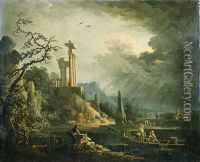Jean-Baptiste-Charles Claudot, Called Clau Nancy Paintings
Jean-Baptiste-Charles Claudot, commonly known as Clau Nancy, was a French painter born in 1733 in Badonviller, Lorraine, France. He was primarily celebrated for his landscapes and pastoral scenes, capturing the serene beauty of the French countryside with a delicate and refined touch. His nickname, 'Clau Nancy,' derives from his association with the city of Nancy, where he was most active and where his style was notably influenced by the local art scene and the cultural milieu of the Lorraine region.
Claudot's early training is not thoroughly documented, but it is believed he was initially taught by his father, who was also an artist, before continuing his education in the studios of more established painters of the time. This period of apprenticeship allowed him to refine his technique and develop a personal style characterized by soft, harmonious colors and meticulous attention to detail.
Throughout his career, Claudot enjoyed the patronage of the local aristocracy and the church, which commissioned him to create works for their estates and places of worship. Despite this, he remained relatively unknown outside of Lorraine for much of his life, his work overshadowed by the grandeur of the Rococo movement and the emerging Neoclassical style.
Jean-Baptiste-Charles Claudot died in 1805 in Nancy. His legacy, though modest in comparison to his contemporaries, holds a special place in the history of French regional painting. Today, his works are appreciated for their quiet beauty and the glimpse they offer into the pastoral life of 18th-century France. Claudot's paintings are preserved in various museums and private collections, primarily in France, serving as a testimony to his skill and the enduring appeal of his pastoral scenes.
